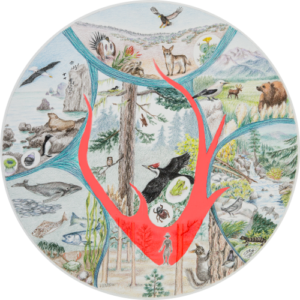Two and a half millennia ago, Hippocrates wrote of the importance of airs, waters, and places. Now, with the institutionalization of medicine, doctors and patients have lost sight of the adverse consequences of habitat damage and also of the positive effects on health, well-being, and survival of the body of life in which humans evolved. Emerging medicine can support doctors in recognizing the urgent need to revitalize the habitats on which they and their patients depend for life. To see this need requires that doctors grasp that life is “externalized”—that is, “valued at nothing” by the late modern economy. It also requires an appreciation for the invisible material aspects of being and interbeing—such as temperature, humidity, and radiation—that form local climates and ecological niches.
Together, the nested frames described below compose a key construct of Evolve Medicine: nested bodies. Unlike the late modern construct of human exceptionalism, which leads doctors to view life outside the human body as a source of “enemy agents,” this biocentric, post-post-modern construct features our interdependence with the lives in which we nest. In this working construct, the individual body is viewed as nested in aggregate bodies such as the human species, the body of the habitat, and the body of life on earth. These aggregate bodies thus form our living context.
Body of the Individual
This image depicts your sevenfold body. Note that no living context is represented. This may help you recognize the modern error of human exceptionalism, you can begin to dispel by grasping the depictions of the nesting of aggregated bodies presented below.

Recall that while your flesh is contained by your skin, you are continually exchanging matter (e.g. oxygen and carbon dioxide) with your milieu, and your interbeing is always interfacing between your being and the aggregated beings of your nested bodies. Put differently, all individual and aggregated beings are constantly caring for you—directly and indirectly. If you return this care, you and yours—and the body of your species—can thrive and survive.
Body of the Species
Your species—with you in it—is rapidly destroying life on earth, mainly (in the US) by land misuse and by the spread of human-associated invasive species. With big-picture thinking, your species could instead care for and rescue life on earth. It’s big enough to do so!

The body of the species is always caring for you via culture in the form of language, dialogue, knowledge, ethos, and so on.
Body of the Habitat
Habitats interface with weather, watercourses, soils, and other aspects of the physical environment. They also combine to create bioregions and life on earth, herein referred to as the body of life. The International Union for Conservation of Nature and Natural Resources recognizes thirteen major categories of wild habitats: forest, savanna, shrubland, grassland, wetlands (inland), rocky areas, caves and subterranean (non-aquatic), desert, marine neritic, marine oceanic, marine deep ocean floor, marine intertidal, and marine coast/supratidal. Within each major category are many minor ones that contain each unique instance of the habitat. Many such are disappearing rapidly, leaving less and less biomass and fewer and fewer sources of oxygen, shade, water purification, rains, and global cooling.

Before Thoreau and Darwin, when the Anthropocene—the human-created era—began to escalate the erasure of self-perpetuating wild habitats, moderns took habitats as sources of free or raw materials that could be owned and consumed. John Muir, George Bird Grinnell, Teddy Roosevelt, and others made efforts to turn the tide of habitat destruction, and emergence can support your care and cure by effecting the transformation from destruction to restoration.
Bioregion
During your infancy, your immune system adapted to your habitat(s) of origin. Later adaptations to habitat may be less satisfactory—perhaps more so if you have moved out of your bioregion and into a more allergenic habitat. There is as yet no consensus as to how to define bioregions. The example used here is the region some call Cascadia, which is home to patches of temperate rainforest that manifest the abundant life that was once plentiful in the New World and that is still taken for granted.

Biome
The sum of all earthly life past, present, and future, and thus the sum of a set of bioregions that is mutually exclusive, comprehensive, and dynamic. Note that this image is almost entirely comprised of the non-living substrates on which life depends.

The biome, or life on earth, can be viewed as a complex superorganism or as the sum or aggregate of all living, biological entities. It is thus an imagined body that reveals the interconnected nature of all life. This body of life—as it has developed since the fifth extinction—is now imperiled by humanity’s late modern way of life, which is spending the future of life; it can be rescued only by humans who restore habitats and reintegrate with them in a sustainable balance. However, restoration and reintegration are not sufficient to cure the body of life, which is suffering from chronic ambient poisoning; such poisoning is not limited to humans, and so affects the bodies of species and habitats that have yet to go extinct. We have—perhaps—a century to reverse the downward spiral of life that we set in motion.
